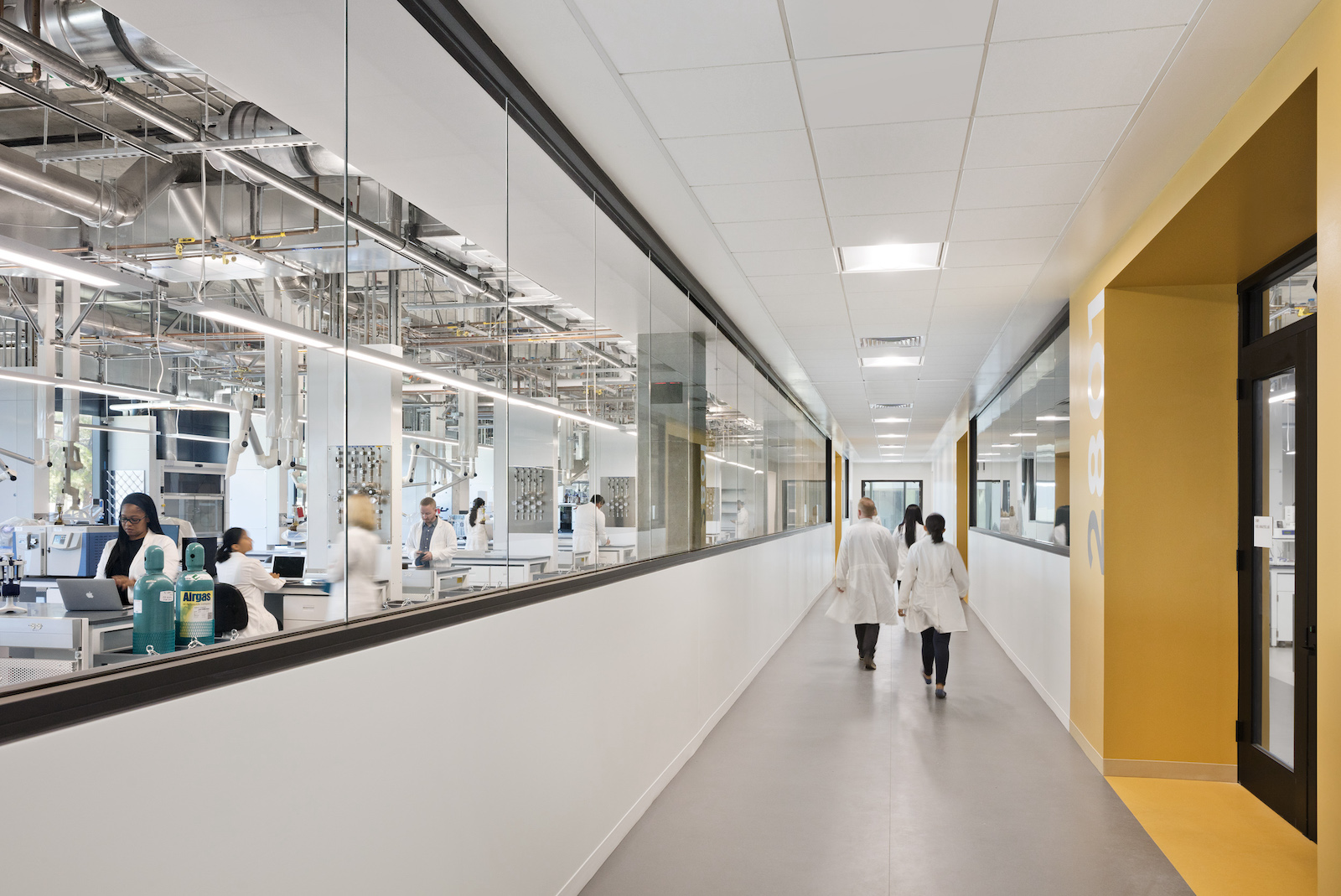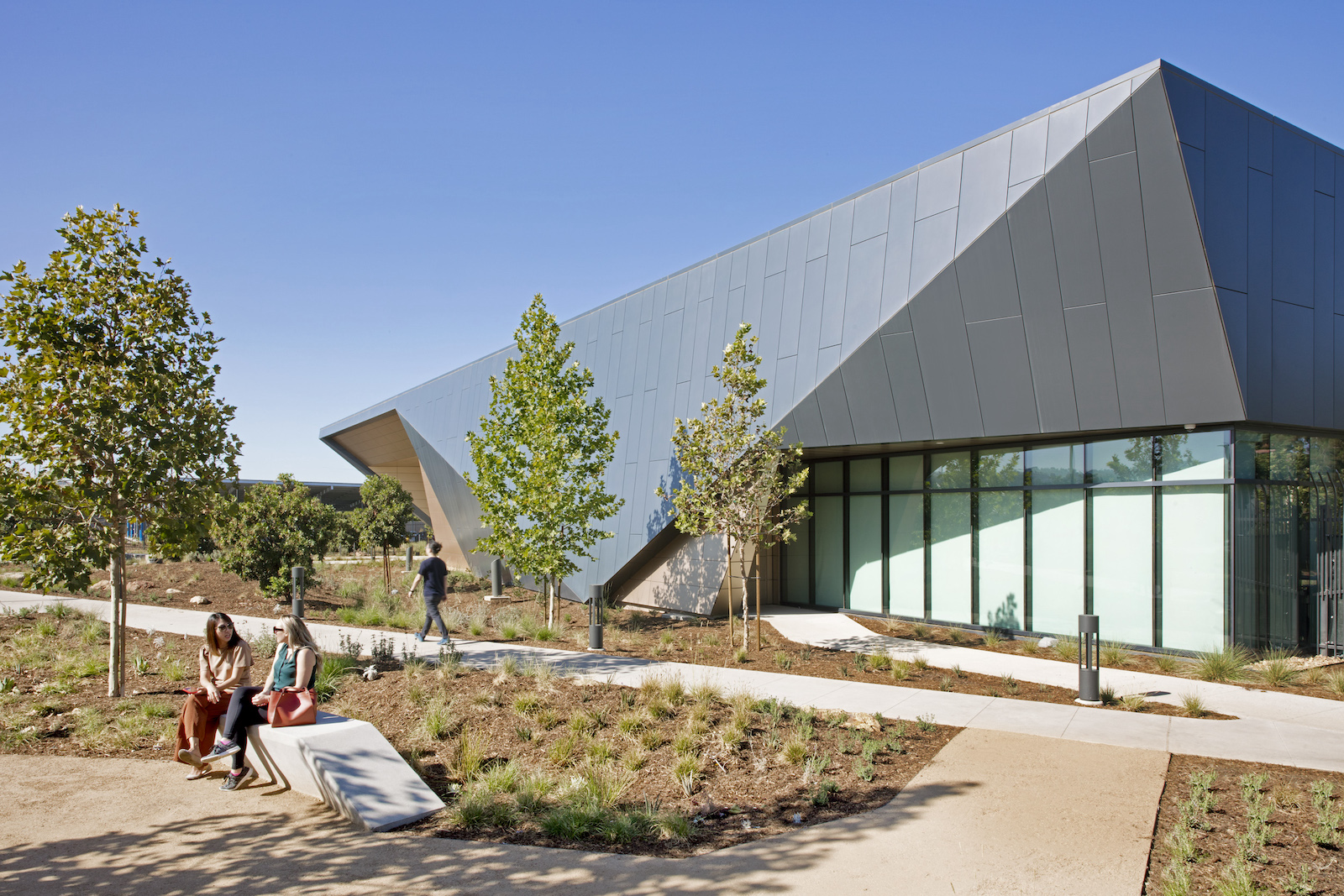The California Air Resources Board (CARB) Southern California headquarters has been completed in Riverside, Calif. The 403,306-sf is the largest vehicle emissions testing facility in the world and the largest net-zero facility of its kind.
The CARB headquarters exceeds California Title 24 requirements by 30% and lowers energy cost savings by 75%. All of the energy needed is produced onsite, making it resilient to power outages and protecting it from pausing its research operations.
CARB consolidated five existing locations across Southern California into CARB’s headquarters which improves performance and efficiency of operations while also providing a healthy workplace for the organization’s employees. The design team’s focus was not just reaching high-performance targets, but creating a quality environment for CARB’s employees.
The features of the headquarters include a complex program with myriad space types, including a main entrance and lobby, an employee entrance and lounge, a large auditorium, open office, conference room, light-and-heavy-duty vehicular emissions testing wings, specialized chemistry and hydrogen laboratories, and employee amenity spaces such as an expensive breakroom and a gym. The facility is sited on 19 acres to encourage biking, walking, public transit, and use of zero emissions vehicles to reduce transportation impacts.
The facility effectively connects users to the outdoors. The layout and form of the building establishes two principle outdoor spaces: the main courtyard to the east and a more private courtyard to the west. The building is oriented around the courtyards to lend itself to easy circulation, views, daylighting, and self-shading. Coupled with an abundance of low B VOC-emission trees and plantings, comfortable outdoor respite spaces are established for employee enjoyment.
The massing of the office building is consolidated into three stories that extend in three directions parallel to light duty testing, chemistry labs, and toward the conference buildings. This creates a smaller building footprint and shortens horizontal circulation networks, while using vertical connectivity established by a network of bridges and stairs to increase proximity between offices, testing areas, support spaces, and laboratories, resulting in increased flexibility, optimized adjacencies, and greater opportunities for intellectual collisions among employees. A variety of types and scales of meeting spaces, as well as coffee bars and cafés promote interaction and collaboration, especially for staff who circulate between the various departments throughout the day.
The ground floor of the open office atrium features testing control desks where employees conduct and operate the air regulation testing that occurs in the test cells. These inset spaces throughout the office building first floor are open and allow all users to see the AC dynamometers, among other testing equipment, in action.
Beyond putting CARB vehicular testing on display, the energy reduction strategies in the office building also largely contribute to the facility’s net-zero energy status. The integration of chilled beams allowed the atrium ceiling to be kept high, making way for the collection of skylights—a passive lighting strategy—that create expansive views of the naturally lit workspace. Paired with task lighting and daylighting harvesting, the office wing, which accounts for 41% of the total program, uses only 15% of the total energy needed to operate the building.

Energy reduction strategies include:
- Fluid cooler - Using hybrid coolers in conjunction with an elevated 570°F chilled water temperature reduced estimated energy consumption of the facility by approximately 8%.
- Aircuity and demand control ventilation - Continuous indoor air monitoring maximizes ventilation efficiency and energy reduction.
- Adiabatic humidification - Air is humidified without using steam or an additional heat source, reducing energy consumption.
- Active chilled beams - The hydronic air cooling system uses less air, reducing energy requirements and overall operating costs.
- Daylighting - Skylights increase interior daylighting. Motorized interior shades reduce glare.
- Lighting - Site lighting: high efficiency LED site in parking. Interior lighting: interiors incorporate all LED lighting, task-ambient lighting, daylight harvesting control, dual lighting / HVAC occupancy sensors.
- Electrical vehicle charging - 118 EV charging stalls provided on site with the ability to expand to a total of 149 EV parking stalls.
- Fume hood occupancy-based control - Occupancy-based sensors integrated into the chemistry lab fume hoods reduce energy demands.
- Exterior louvers - Exterior louvers integrated into the southeast and west facades reduce solar heating and glare.
- High-performance glazing - Low-e insulated glazing with exterior louvers increase operational energy efficiency.
The facility was completed in August 2021. ZGF worked with Hensel Phelps and Affiliated Engineers on the project.
Related Stories
Contractors | Apr 10, 2023
What makes prefabrication work? Factors every construction project should consider
There are many factors requiring careful consideration when determining whether a project is a good fit for prefabrication. JE Dunn’s Brian Burkett breaks down the most important considerations.
Architects | Apr 6, 2023
New tool from Perkins&Will will make public health data more accessible to designers and architects
Called PRECEDE, the dashboard is an open-source tool developed by Perkins&Will that draws on federal data to identify and assess community health priorities within the U.S. by location. The firm was recently awarded a $30,000 ASID Foundation Grant to enhance the tool.
Sustainability | Apr 4, 2023
NIBS report: Decarbonizing the U.S. building sector will require massive, coordinated effort
Decarbonizing the building sector will require a massive, strategic, and coordinated effort by the public and private sectors, according to a report by the National Institute of Building Sciences (NIBS).
Government Buildings | Mar 24, 2023
19 federal buildings named GSA Design Awards winners
After a six-year hiatus, the U.S. General Services Administration late last year resumed its esteemed GSA Design Awards program. In all, 19 federal building projects nationwide were honored with 2022 GSA Design Awards, eight with Honor Awards and 11 with Citations.
Industry Research | Mar 2, 2023
Watch: Findings from Gensler's latest workplace survey of 2,000 office workers
Gensler's Janet Pogue McLaurin discusses the findings in the firm's 2022 Workplace Survey, based on responses from more than 2,000 workers in 10 industry sectors.
Airports | Feb 28, 2023
Data visualization: $1 billion earmarked for 2023 airport construction projects
Ninety-nine airports across 47 states and two territories are set to share nearly $1 billion in funding in 2023 from the Federal Aviation Administration. The funding is aimed at help airports of all sizes meet growing air travel demand, with upgrades like larger security checkpoints and more reliable and faster baggage systems.
Multifamily Housing | Feb 16, 2023
Coastal Construction Group establishes an attainable multifamily housing division
Coastal Construction Group, one of the largest privately held construction companies in the Southeast, has announced a new division within their multifamily sector that will focus on the need for attainable housing in South Florida.
Giants 400 | Feb 9, 2023
New Giants 400 download: Get the complete at-a-glance 2022 Giants 400 rankings in Excel
See how your architecture, engineering, or construction firm stacks up against the nation's AEC Giants. For more than 45 years, the editors of Building Design+Construction have surveyed the largest AEC firms in the U.S./Canada to create the annual Giants 400 report. This year, a record 519 firms participated in the Giants 400 report. The final report includes 137 rankings across 25 building sectors and specialty categories.
Codes and Standards | Feb 8, 2023
GSA releases draft of federal low embodied carbon material standards
The General Services Administration recently released a document that outlines standards for low embodied carbon materials and products to be used on federal construction projects.
Giants 400 | Feb 6, 2023
2022 Reconstruction Sector Giants: Top architecture, engineering, and construction firms in the U.S. building reconstruction and renovation sector
Gensler, Stantec, IPS, Alfa Tech, STO Building Group, and Turner Construction top BD+C's rankings of the nation's largest reconstruction sector architecture, engineering, and construction firms, as reported in the 2022 Giants 400 Report.
















